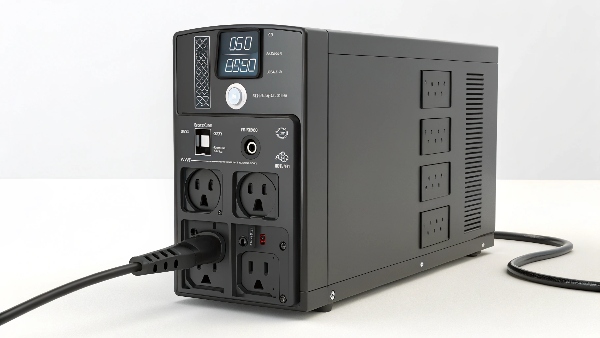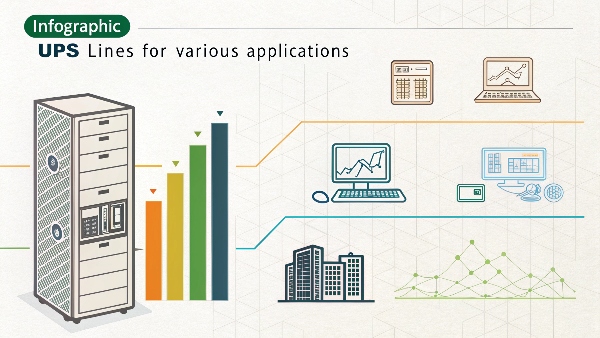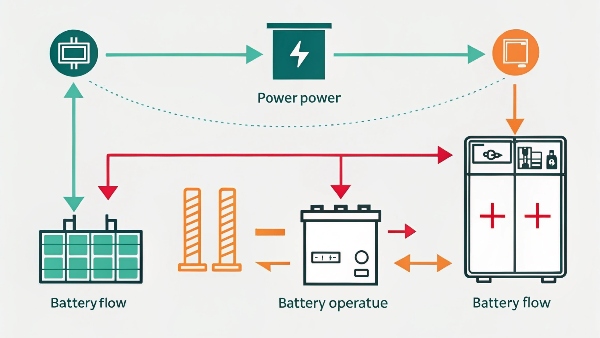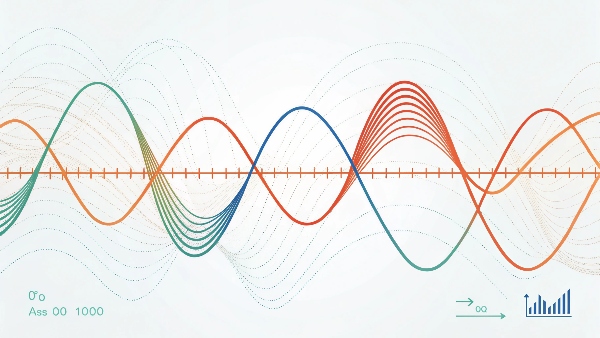Confused about what a "UPS line" really means for your critical systems? Misunderstanding this could lead to choosing the wrong power protection solution. Let's clarify what this term means for reliable backup power.
A UPS line typically refers to a range or series of Uninterruptible Power Supply products offered by a manufacturer. These lines are often categorized by technology (e.g., standby, line-interactive, online), capacity, or intended application, signifying a portfolio of power protection solutions.

This idea of a "UPS line" might sound simple, but it actually covers a lot of different products and technologies. I've been an OEM/ODM manufacturer of UPS systems for 10 years, and I've seen how vital it is for my clients to understand these differences. Our clients include procurement managers for large hospital infrastructure companies and system integrators building out data centers. They need to know exactly what they're getting. We will look into what a UPS is first. Then, we will explore the different types or "lines" available. This will help you make smart choices for your power protection needs.
What is an uninterrupted power supply unit UPS?
Power outages can stop your business or corrupt important data very quickly. Without protection, you face costly downtime and possible equipment damage. An Uninterruptible Power Supply (UPS) unit is your immediate help.
An Uninterruptible Power Supply (UPS) unit is a device that gives emergency power to connected equipment when the main power source fails. It has a battery that starts working instantly. This prevents data loss and allows for a safe shutdown of your equipment.

At its heart, an Uninterruptible Power Supply unit, or UPS, is a guardian for your electronics. Its main job is to provide a clean, stable source of power when the utility power coming from the wall outlet disappears or becomes unstable. Think of it as a small, dedicated power plant just for your essential devices. The core components that make this happen are a rechargeable battery, an inverter (to change the battery's DC power to AC power that your devices use), a battery charger, and a transfer switch that detects power problems and switches to battery power. I've seen how hospitals depend on our UPS systems for critical life-support machines; any interruption is not an option. Similarly, data centers use our robust UPS solutions to ensure their servers are always online, processing information without a hitch. As an OEM/ODM manufacturer, we specialize in designing and customizing these core components. We make sure they are reliable and meet the specific voltage, capacity, and application needs of our global clients, whether they need cost-effective lead-acid battery UPS solutions or high-efficiency lithium battery UPS systems. Our patented technology often improves how these components work together for better performance.
What is a UPS line?
There are so many UPS options, how do you know what "line" or type is right for you? Choosing the wrong one means you might waste money or not get enough protection for what you need. Understanding "UPS line" helps you see product families and what they are designed for.
A "UPS line" refers to a specific series or family of UPS products from a manufacturer. These lines are often differentiated by their technology (e.g., standby, line-interactive, online), capacity range, form factor, or target application, like data centers or home offices.

When we talk about a "UPS line," we're talking about a group of UPS products that a manufacturer offers. These products are usually grouped together because they share similar features or are designed for similar uses. For example, at [Your Company Name], we have different UPS lines. Our "Lead-Acid Battery UPS Solutions" line offers cost-effective and reliable power backup for a wide range of applications. This line is popular with wholesalers and retailers looking for dependable options for general use. Then we have our "Lithium Battery UPS Solutions" line. These units are designed for higher efficiency, longer life, and are great for modern energy demands, often sought by clients needing advanced solutions. We might also develop a specific line for a particular industry, like a line of UPS systems built to be extra tough for industrial environments, or a line of very small units for retail point-of-sale systems.
Procurement managers, like Mr. Li at a hospital, or technical directors at construction companies, often look for a UPS line that meets specific international standards, such as CE, RoHS, and ISO certifications, which all our products comply with. They might also need a line that uses a particular technology, like online double-conversion for their critical servers. As an OEM/ODM partner, we develop these lines based on what the market needs and what our clients tell us. Sometimes a client needs a whole line of UPS systems designed just for them, and we can do that too. For example, a large enterprise might need a line of UPS units with specific communication ports for their network management system, and we can design and manufacture that line.
| UPS Line Category | Key Technology | Typical Application | Primary Benefit |
|---|---|---|---|
| Home/Small Office | Standby | PCs, Modems, Routers | Most Affordable |
| Business/Workstation | Line-Interactive | Workstations, Small Servers | Voltage Regulation |
| Network/Server | Line-Interactive or Online | Servers, Network Gear | Higher Capacity, Management Features |
| Critical/Data Center | Online Double-Conversion | Data Centers, Hospitals | Maximum Protection |
What is UPS and how does it work?
Utility power is often not reliable. It can cause sudden shutdowns and corrupt your data. These problems mean lost work, damaged equipment, and a lot of frustration. A UPS steps in. It gives you a smooth bridge of power protection.
A UPS (Uninterruptible Power Supply) is a device that gives backup power from a battery when utility power fails. It senses the power outage. Then, it instantly switches to battery power. This keeps connected equipment running or lets you shut it down safely.

So, how does a UPS actually do its job? It's quite clever. During normal operation, when the power from your wall outlet (mains power) is fine, the UPS passes this power directly to your connected equipment, like your computer or server. At the same time, it uses a little of this power to keep its internal battery fully charged. Inside the UPS, there's a very smart component called a transfer switch1. This switch is constantly monitoring the incoming utility power. If it detects a problem – like a complete blackout, a sag (low voltage), or a surge (high voltage) – it acts incredibly fast. Within milliseconds, it switches the power source for your equipment from the failing utility power to the UPS's internal battery. The battery provides DC power. So, another key component, the inverter, instantly converts this DC power into AC power that your devices can use. Your equipment continues to run smoothly, often without you even noticing the switch, until the battery runs out or utility power is restored. The amount of time it can run on battery is called the "runtime2," and it depends on the battery's size and how much power your connected devices are drawing. When good utility power comes back, the transfer switch changes your equipment back to mains power, and the UPS starts recharging its battery again. This seamless transition is why it's called "uninterruptible." As manufacturers, our team of professionals focuses heavily on the reliability of this transfer mechanism and the efficiency of the inverter. Our comprehensive testing ensures this process works flawlessly every time, meeting the strict CE, RoHS, and ISO standards expected by our global clients for their critical infrastructure.
What is the meaning of uninterrupted supply?
Even a very short power flicker can corrupt your files or stop important processes. This "interruption" is exactly what businesses and critical services cannot handle. "Uninterrupted supply" means you get continuous, clean power, no matter what happens with the utility.
"Uninterrupted supply" means providing a continuous and stable flow of electrical power to connected devices. This happens without any break or big change in power, even when the main utility power source fails or has problems like sags or surges.

"Uninterrupted supply" is the core promise of a UPS. It means more than just keeping the lights on during a total blackout. It means ensuring that the power flowing to your sensitive electronic equipment is constant and clean. Many power problems are not full outages but are more subtle, like voltage sags (dips), swells (brief increases), or electrical noise. These can also stress or damage electronics over time. A good UPS, especially line-interactive and online double-conversion types, actively conditions the power. This means it smooths out these smaller fluctuations, providing a consistently stable power source. For a client like Mr. Li, a Procurement Manager at a Hospital Infrastructure Company, "uninterrupted" is absolutely critical. For life support systems or sensitive diagnostic equipment, even a pause of a few milliseconds in power supply could have serious consequences. This is where our high-quality online double-conversion UPS lines are essential, as they completely regenerate the power, offering the highest level of isolation from utility power issues. Similarly, for data centers managing financial transactions or large databases, any interruption can mean lost data, failed transactions, and significant financial loss. Our commitment as an OEM/ODM manufacturer is to build UPS systems, whether they use lead-acid or our advanced lithium battery technology, that truly deliver on this promise of uninterrupted supply. Our patented technologies often focus on enhancing this continuous power delivery, perhaps through even faster transfer times or more sophisticated power conditioning. The extensive testing and certifications (CE, RoHS, ISO) we undertake are all designed to prove this capability, ensuring our clients worldwide, who depend on us for critical infrastructure projects, receive reliable solutions. We make sure our dedicated teams can clearly explain, in English, how our products achieve this level of performance.
Conclusion
A UPS line offers various solutions for continuous power. Understanding these options ensures your specific critical equipment gets the dedicated backup power support it truly needs for reliable operation.

